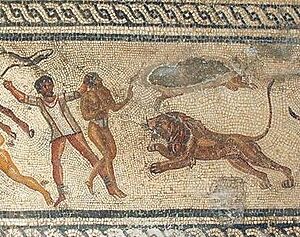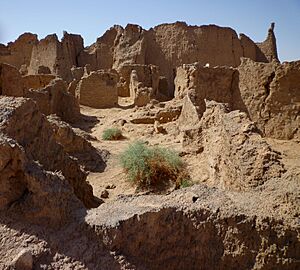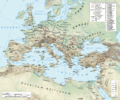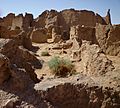Garamantes facts for kids

The Garamantes were an ancient people who lived in the Fezzan region of southern Libya. They might have come from Berber and Toubou tribes, as well as desert herders. They settled in the area around 1000 BC and built a strong civilization that lasted until the late 600s AD.
The Garamantes became a major power in the mid-100s AD. Their kingdom covered about 70,000 square miles (181,300 km²). Their success came from a clever irrigation system called qanats (or foggaras). This system helped them grow lots of crops and support a large population. They created the first city-based society in a big desert that wasn't near a river. Their biggest town, Garama, had about 4,000 people, with another 6,000 living nearby. At their peak, the Garamantes had a much better way of life than any other ancient desert society. They were skilled farmers, clever engineers, and smart traders who built an amazing civilization.
Contents
Who Were the Garamantes?
The Garamantes likely came from tribes and herding groups who settled in the Fezzan region around 1000 BC. Early people in this area, called Final Pastoral peoples, changed their society and built special burial sites. These sites, dating back about 3,000 years, contained valuable items from far away. This helped lead to the Garamantian kingdom.
These early groups also had contact with the Garamantes. The Garamantes later gained control over the oasis-based economy in southern Libya. Some ideas suggest that people from the Tichitt culture in Mauritania might have influenced Garamantian building styles and pottery. This could be because women from the Sahel region married into Garamantian society.
A Look at Their History
The first known written mention of the Garamantes is from the 400s BC. The Greek historian Herodotus described them as a "very great nation" who raised cattle and grew dates. He also wrote that the Garamantes used chariots pulled by four horses to hunt "Troglodyte Ethiopians." Herodotus noted that the people in northern and southern Libya were original inhabitants, while Phoenicians and Greeks settled later.
Other ancient Greek and Roman writers also mentioned the Garamantes. Some Roman writers described them as having ritual scars and tattoos. The historian Tacitus wrote that they helped a rebel named Tacfarinas and attacked Roman towns along the coast.
According to Pliny the Elder, the Romans, led by Lucius Cornelius Balbus, captured fifteen Garamantian settlements in 19 BC because of their constant raids. Later, in 202 AD, the Roman emperor Septimius Severus captured their capital city, Garama.
The Garamantian culture began to decline around the late 600s AD. This might have been due to changes in the climate or using too much water. The desert areas they lived in were once good farmland, made even better by their irrigation system. However, the water they used was fossil water, which is not replaced naturally. Over many centuries, the underground water levels dropped, which likely contributed to the end of their kingdom.
Life in Garamantian Society

In the 1960s, archaeologists started digging up parts of the Garamantes' capital, which is now called modern Germa. They named the ancient city Garama. An earlier capital, Zinkekara, was also nearby.
Today, we know the Garamantes had about eight main towns, and archaeologists have explored three of them. They also had many smaller settlements. Garama itself had about 4,000 people, with another 6,000 living in villages within 3 miles (5 km) of the city. The entire valley could have supported up to 50,000 people.
Studies of Garamantian skeletons suggest that their daily lives were not extremely hard or filled with constant warfare. Their bones show that men and women had similar upper body strength, which is common in farming communities. This means that men likely weren't involved in intense fighting or heavy construction work all the time. Life in the Sahara, for them, didn't seem to require unusually strenuous activities compared to other North African groups.
Archaeological sites linked to the Garamantian kingdom include many tombs, forts, and cemeteries. The Garamantes built a complex system of tunnels and shafts to get fossil water from under the desert sand. These tunnels, known to Berbers as Foggaras, allowed farming to thrive. This system was maintained using a system of labor.
Language and Writing
The Garamantes may have used a form of writing called proto-Tifinagh. This script is related to the writing used by modern Berber peoples. Many inscriptions have been found near Jarma, the Garamantian capital. These are carved or painted on pottery and in tombs.
While the inscriptions use Berber characters, not all of them can be easily read. Some experts think the messages might have been coded, or perhaps they were just for fun. Another interesting idea is that they might have been written in a different language, perhaps a Nilo-Saharan language or something unknown.
Images for kids
-
Map of the Roman Empire under Hadrian (ruled 117 – 138 AD), showing where the Garamantes lived in the desert south of the Roman province of Africa proconsularis (modern Tunisia and Libya).
-
Location of the Garamantes in the Fezzan around 600 AD, before the Islamic conquest.







